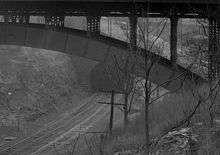Schenley Tunnel
Schenley Tunnel (also known as the Neville Street Tunnel[2] and Pittsburgh Junction Railroad Tunnel) is a railroad tunnel in Pittsburgh, Pennsylvania, United States. The tunnel runs beneath Neville Street in the city's North Oakland neighborhood; the south portal is at the upper end of Junction Hollow, the north in a ravine that opens into Skunk Hollow, between North Oakland and Bloomfield.
_(cropped).jpg) The south portal in 2016. | |
| Overview | |
|---|---|
| Other name(s) |
|
| Line | P&W Subdivision |
| Location | beneath Neville Street in the Oakland and Shadyside neighborhood area. |
| Coordinates | 40.44631°N 79.94737°W |
| Operation | |
| Constructed | May 1883 – December 1884 |
| Opened | September 1884 |
| Technical | |
| Length | 2,872.4 feet (875.5 m)[1] |
| No. of tracks | 1 (originally 2) |
| Track gauge | 1,435 mm (4 ft 8 1⁄2 in) standard gauge |
Schenley Tunnel measures 2,872 feet (875 m) in length and runs about 70 feet (21 m) beneath Neville Street. It carries CSX Transportation's P&W Subdivision. The Allegheny Valley Railroad, a short-line railroad, uses the tunnel for regional services. Amtrak's Capitol Limited also uses the tunnel when entering and leaving the city.
History
Excavation on the tunnel began about May 1883[3] and continued for nine months.[4] By August 1883, a vertical shaft reached the tunnel's midpoint, and additional excavation began from the inside, working in both directions.[5] In May 1884, brick masons were hired to build the arched passage lining the tunnel.[6] The track was completed on September 24, 1884[4] and the Pittsburgh Daily Post reported that an informal opening for involved business leaders was held September 30, 1884, but noted that about 25 feet of the tunnel remained to be bricked.[7][8] The official opening was delayed until December 1884, when the Junction Railroad's bridge across the Allegheny River and Herr's Island was opened, completing the connecting railroad.[9]
Shaw, Stearns & Norris, railroad builders from Columbus, Ohio were the contractors.[9] The entire Junction Railroad, about four miles long, including the tunnel and a bridge crossing the Allegheny River at 33rd Street, cost about $1.9 million (equivalent to $54 million in 2019).[4] While the original Schenley tunnel is still in use, the bridge was replaced in 1920.[10]

References
- "Pittsburgh Junction RR Tunnel". Bridges and Tunnels of Allegheny County and Pittsburgh, PA. Retrieved 3 April 2018.
- Grata, Joe (February 2016). "Underground Pittsburgh: Explore our City of Tunnels". Pittsburgh Magazine.
- "Capital and labor notes". Pittsburgh Commercial Gazette. May 19, 1883. p. 2. Retrieved February 25, 2018 – via Newspapers.com.

- "Ready for work: The last rail placed on the Junction Railroad". Pittsburgh Commercial Gazette. September 25, 1884. p. 2. Retrieved February 25, 2018 – via Newspapers.com.

- "Work on the Junction Tunnel". Pittsburgh Commercial Gazette. August 8, 1883. p. 2. Retrieved February 25, 2018 – via Newspapers.com.

- "Wanted — 20 brickmasons". Pittsburgh Commercial Gazette. May 19, 1884. p. 3. Retrieved February 25, 2018 – via Newspapers.com.

- "Jaunt on the Junction: The connecting link of two great roads informally opened". Pittsburgh Daily Post. October 1, 1884. p. 4. Retrieved February 25, 2018 – via Newspapers.com.

- "Death takes noted capitalist". Pittsburgh Gazette Times. December 6, 1906. p. 2. Retrieved February 25, 2018 – via Newspapers.com.

- "The great short cut: Finishing touches to the Junction Road". The Evening Penny Press. Pittsburgh. December 11, 1884. p. 1. Retrieved February 25, 2018 – via Newspapers.com.

- "Railroad news: Spans rolled into place". Pittsburgh Post. September 28, 1920. p. 14. Retrieved March 1, 2018 – via Newspapers.com.

- Toker, Franklin (1994) [1986]. Pittsburgh: An Urban Portrait. Pittsburgh: University of Pittsburgh Press. ISBN 0-8229-5434-6.